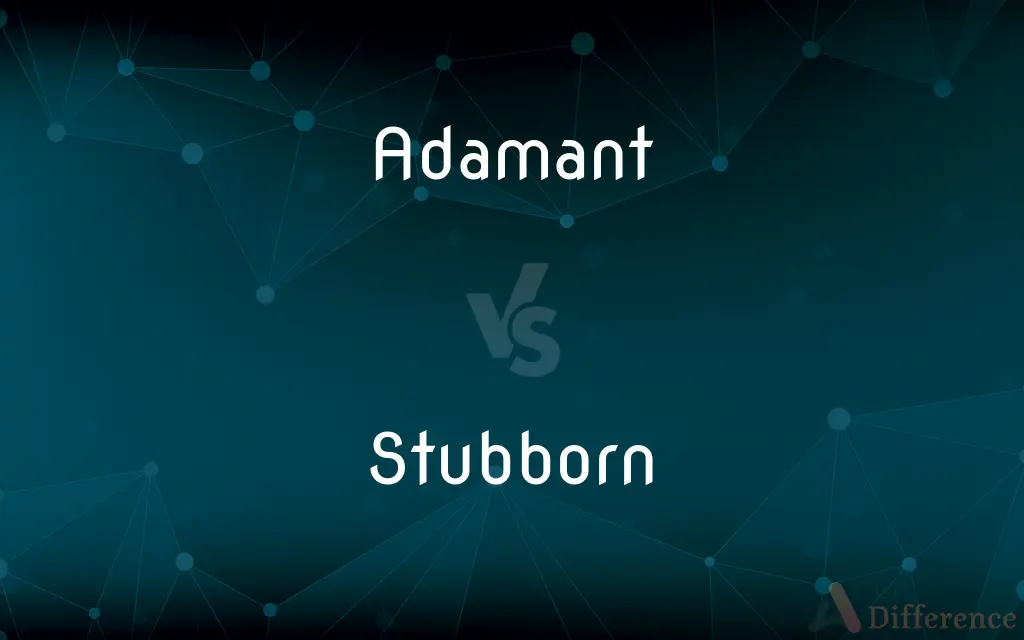Adamant vs. Stubborn — What's the Difference?
By Fiza Rafique & Urooj Arif — Updated on April 15, 2024
Adamant refers to an unyielding firmness in stance or decision, often perceived as resolute, while stubbornness denotes a refusal to change one’s opinion or course of action, typically viewed negatively.

Difference Between Adamant and Stubborn
Table of Contents
ADVERTISEMENT
Key Differences
Adamant characterizes a person's unwavering determination to stick to a decision or belief, suggesting strength and resolve. In contrast, being stubborn often implies a negative connotation, where the persistence is seen as irrational or unreasonable.
While adamant individuals may be admired for their steadfast principles and clear commitment to their values, stubborn people might be criticized for their inflexibility and failure to consider other perspectives or evidence. This distinction highlights how similar behaviors can be interpreted differently depending on context and outcomes.
Being adamant is often considered a virtue in contexts where moral conviction or professional integrity is at stake, reflecting a positive assertiveness. On the other hand, stubbornness can be viewed as a hindrance in collaborative or dynamic situations where adaptability and openness are required.
In negotiations or debates, an adamant person is perceived as strong and principled, often commanding respect for their clarity and firmness. Conversely, a stubborn individual may be seen as difficult or obstructive, potentially undermining their position or relationships with others.
In leadership, adamant leaders are often praised for their clear vision and unwavering dedication to goals, inspiring confidence and loyalty. Whereas, stubborn leaders might be viewed as dictatorial or unresponsive to feedback, which can lead to discord and inefficiency.
ADVERTISEMENT
Comparison Chart
Connotation
Generally positive, implies resoluteness and firmness
Generally negative, implies unreasonable inflexibility
Interpretation in context
Seen as a virtue in moral or integrity-based situations
Often viewed as a flaw, especially in collaborative settings
Impact in leadership
Inspires confidence and loyalty, seen as principled
Can cause discord, seen as dictatorial or inflexible
Perception in disputes
Respected for clarity and firm stance
Seen as obstructive and difficult
Adaptability
Lacks flexibility but admired for constancy
Criticized for lack of adaptability and openness
Compare with Definitions
Adamant
Unyielding in attitude or opinion.
He remained adamant about his innocence.
Stubborn
Refusing to change one's mind or course.
His stubborn resistance to new ideas was frustrating.
Adamant
Impervious to pleas or persuasion.
Despite the backlash, the leader was adamant.
Stubborn
Inflexible or unyielding disposition.
The stubborn child wouldn't eat his vegetables.
Adamant
Firmly fixed or decided.
She was adamant that the project be completed on time.
Stubborn
Resistant to influence or control.
The stubborn virus was not responding to treatment.
Adamant
Steadfast in purpose.
Their adamant support for the cause never wavered.
Stubborn
Obstinately adhering to an opinion.
She was stubborn in her refusal to acknowledge the mistake.
Adamant
Resolute determination.
Her adamant refusal to compromise impressed her peers.
Stubborn
Persistent in an irrational manner.
His stubborn loyalty to the failing strategy cost the company dearly.
Adamant
Adamant in classical mythology is an archaic form of diamond. In fact, the English word diamond is ultimately derived from adamas, via Late Latin diamas and Old French diamant.
Stubborn
Having or showing dogged determination not to change one's attitude or position on something, especially in spite of good arguments or reasons to do so
Two stubborn young people intent on doing their own thing
A stubborn refusal to learn from experience
Adamant
Refusing to be persuaded or to change one's mind
He is adamant that he is not going to resign
Stubborn
Refusing to change one's mind or course of action despite pressure to do so; unyielding or resolute.
Adamant
A legendary rock or mineral to which many properties were attributed, formerly associated with diamond or lodestone.
Stubborn
Characterized by a refusal to change one's mind or course of action; dogged or persistent
Stubborn prejudice.
Stubborn earnestness.
Adamant
Not willing to change one's opinion, purpose, or principles; unyielding.
Stubborn
Difficult to treat or deal with; resistant to treatment or effort
Stubborn soil.
Stubborn stains.
Adamant
A stone once believed to be impenetrable in its hardness.
Stubborn
Of materials: physically stiff and inflexible; not easily melted or worked.
Adamant
An extremely hard substance.
Stubborn
(informal) Stubbornness.
Adamant
(said of people and their conviction) Firm; unshakeable; unyielding; determined.
Stubborn
A disease of citrus trees characterized by stunted growth and misshapen fruit, caused by Spiroplasma citri.
Adamant
(of an object) Very difficult to break, pierce, or cut.
Stubborn
Firm as a stub or stump; stiff; unbending; unyielding; persistent; hence, unreasonably obstinate in will or opinion; not yielding to reason or persuasion; refractory; harsh; - said of persons and things; as, stubborn wills; stubborn ore; a stubborn oak; as stubborn as a mule.
And I was young and full of ragerie [wantonness]Stubborn and strong, and jolly as a pie.
These heretics be so stiff and stubborn.
Your stubborn usage of the pope.
Adamant
An imaginary rock or mineral of impenetrable hardness; a name given to the diamond and other substances of extreme hardness.
Stubborn
Tenaciously unwilling or marked by tenacious unwillingness to yield
Adamant
An embodiment of impregnable hardness.
Stubborn
Not responding to treatment;
A stubborn infection
A refractory case of acne
Adamant
(obsolete) A lodestone.
Stubborn
Difficult to treat or deal with;
Stubborn rust stains
A stubborn case of acne
Adamant
A stone imagined by some to be of impenetrable hardness; a name given to the diamond and other substances of extreme hardness; but in modern mineralogy it has no technical signification. It is now a rhetorical or poetical name for the embodiment of impenetrable hardness.
Opposed the rocky orbOf tenfold adamant, his ample shield.
Stubborn
Persisting in a reactionary stand
Adamant
Lodestone; magnet.
As true to thee as steel to adamant.
Adamant
Very hard native crystalline carbon valued as a gem
Adamant
Not capable of being swayed or diverted from a course; unsusceptible to persuasion;
He is adamant in his refusal to change his mind
Cynthia was inexorable; she would have none of him
An intransigent conservative opposed to every liberal tendancy
Common Curiosities
What does adamant mean?
Adamant means unyieldingly firm and resolute, especially in one’s stance or decision.
How are adamant and stubborn perceived differently?
Adamant is generally seen as positive, denoting strength and resolve, whereas stubborn is often viewed negatively, indicating irrational or excessive inflexibility.
What does stubborn mean?
Stubborn describes someone who is inflexible and refuses to change their opinion or course of action, often irrationally.
Why might adamant be considered a virtue?
Being adamant is considered a virtue in scenarios where standing firm on one’s principles or decisions is crucial and morally justified.
What is the impact of stubbornness in teamwork?
Stubbornness in teamwork can lead to conflict, inefficiency, and a failure to adapt to new ideas or necessary changes.
How does adamant behavior affect leadership?
Adamant behavior in leadership can inspire loyalty and confidence due to a clear and consistent vision.
Can a person be both adamant and stubborn?
Yes, a person can exhibit both qualities; they can be adamant when their firmness is justified or principled, and stubborn when it becomes unreasonable or inflexible.
What are the drawbacks of being stubborn?
The main drawback of being stubborn is the potential to alienate others, hinder progress, and ignore beneficial changes or inputs.
Can stubbornness ever be beneficial?
Stubbornness can be beneficial in situations where persistence is necessary to achieve goals, despite challenges or opposition.
How can one manage a stubborn individual effectively?
Managing a stubborn individual effectively involves patience, clear communication, and sometimes compromise to demonstrate the value of different perspectives.
Share Your Discovery

Previous Comparison
Perspirate vs. Sweat
Next Comparison
Msg vs. MagAuthor Spotlight
Written by
Fiza RafiqueFiza Rafique is a skilled content writer at AskDifference.com, where she meticulously refines and enhances written pieces. Drawing from her vast editorial expertise, Fiza ensures clarity, accuracy, and precision in every article. Passionate about language, she continually seeks to elevate the quality of content for readers worldwide.
Co-written by
Urooj ArifUrooj is a skilled content writer at Ask Difference, known for her exceptional ability to simplify complex topics into engaging and informative content. With a passion for research and a flair for clear, concise writing, she consistently delivers articles that resonate with our diverse audience.














































